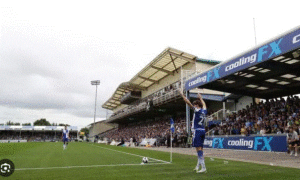Bristol Rovers have been based at the 28-acre sit on Hortham Lane since 2020
As part of a regional strategy for extensive housing development, the South Gloucestershire Council has designated a portion of the Bristol Rovers training site in Almondsbury for the construction of 70 dwellings.
The Quarters Colony Farm, Hortham Village, is included in the “preferred strategy” of the 251-page draught local plan, which was released earlier this month. It specifies the locations of 20,490 residences that should be constructed up to the year 2040. Although no specific maps have been released yet, public comment on the general plan is scheduled to begin on December 4.
For over 9,000 homes—including The Quarters—that lacked planning permission or locations allotted to them in earlier iterations of the housing and employment strategy, the local government has had to locate land.
After training as tenants at Cribbs Sport and Social Club and the University of Bristol’s Coombe Dingle complex, Rovers have been permanently based at Hortham Lane since October 2020. Dwane Sports initially purchased the land in February 2017, and the club has made numerous improvements to the pitches and the central clubhouse.
The 28-acre location is also desired to house the women’s team and academy. In September, a poll was distributed to the community to examine potential ideas for the area’s future.
Respondents were invited to choose which specific developments they would like to see, including open green spaces, public pathways, private medical facilities, a match-ready community football pitch, and other sports facilities.
“We have held positive discussions regarding our ambitions to develop The Quarters to further meet the requirements of the first team, the academy and our commercial aspirations,” CEO Tom Gorringe wrote in his programme notes prior to the September game against Wigan Athletic.
In order to get their feedback on a project that we believe can benefit the community and the public in general while also enhancing the club’s amenities, we have formally engaged with the locals.

“We will make sure that supporters are informed as soon as there are any official updates regarding our infrastructure improvements.”
“We have plans to develop the training ground, increasing it for our team and bringing (in) the academy and have some public facilities to assist with the local residents and to utilise the training ground to benefit the club, the academy, and the local residents,” chairman and co-owner Hussain Alsaeed said in response to a question from BBC Radio Bristol in October regarding future plans for the training ground.
Following the collapse of the Fruit Market proposal to build a new stadium elsewhere in the city, Rovers are currently developing the Mem. The South Stand is almost finished after obtaining planning approval last week.
As part of stage two of the project, the club also wants to upgrade and improve the East Stand, which will be followed by Thatchers End. This could increase the stadium’s capacity to about 17,000 people.
Hussain Alsaeed said to BBC Radio Bristol when questioned about funding a project of that nature: “We can find banks or other financial institutions that can finance this because it will increase the revenue.” We are doing all of that on behalf of the club in order to keep it afloat, boost revenue, and keep the sport budget as high as possible, so it’s very important to get our stadium done well.”
Leave a Reply